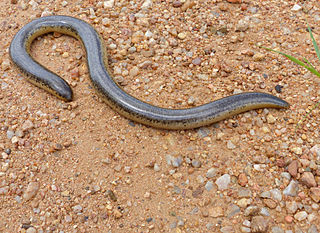
The Typhlopidae are a family of blind snakes. They are found mostly in the tropical regions of Africa, Asia, the Americas, and all mainland Australia and various islands. The rostral scale overhangs the mouth to form a shovel-like burrowing structure. They live underground in burrows, and since they have no use for vision, their eyes are mostly vestigial. They have light-detecting black eye spots, and teeth occur in the upper jaw. Typhlopids do not have dislocatable lower jaw articulations restricting them to prey smaller than their oral aperture. The tail ends with a horn-like scale. Most of these species are oviparous. Currently, 18 genera are recognized containing over 200 species.
The Angolan giant blind snake, also known as the anomalous beaked blind snake, is a species of snake in the Typhlopidae family. It is endemic to Angola. Its classification was changed from Rhinotyphlops to Megatyphlops when Rhinotyphlops was found to be polyphyletic. In 2014 Megatyphlops was changed to Afrotyphlops.
Rhinotyphlops boylei, commonly known as Boyle's beaked blind snake, is a species of snake in the family Typhlopidae. The species is native to southern Africa.
The Gabon beaked snake is a species of blind snake in the family Typhlopidae. It is endemic to Sub-Saharan Africa. It is known from Gabon, Cameroon, the Republic of the Congo, the Democratic Republic of the Congo, and Ghana. However, the identity of different populations is not fully clear.
Cross's beaked snake is a species of snake in the family Typhlopidae. The species is native to West Africa.
The St. Thomas beaked snake is a species of snake in the family Typhlopidae. The species is native to the Gulf of Guinea off the western coast of Central Africa.
Letheobia graueri, also known commonly as the Lake Tanganyika gracile blind snake, Grauer's gracile blind snake, Sternfeld's beaked snake, and Grauer's blind snake, is a species of snake in the family Typhlopidae. The species is endemic to central and eastern Africa.
Letheobia newtoni is a species of snake in the family Typhlopidae.
The Zanzibar beaked snake is a species of blind snake in the Typhlopidae family. It is endemic to Africa.
Rhinotyphlops scorteccii, commonly known as Scortecci's blind snake, is a species of snake in the family Typhlopidae. The species is endemic to Somalia.
Stejneger's beaked snake is a species of snake in the family Typhlopidae. The species is native to Middle Africa.
Letheobia wittei, also known commonly as De Witte's gracile blind snake or Witte's beaked snake, is a species of snake in the family Typhlopidae. The species is endemic to Africa.
Steinhaus's worm snake is a species of snake in the family Typhlopidae. The species is endemic to Central Africa.

Afrotyphlops schlegelii, commonly known as Schlegel's beaked blind snake or Schlegel's giant blind snake, is a species of snake in the family Typhlopidae. The species is endemic to eastern and southern Africa, and bears the distinction of being the world's largest typhlopid. It is harmless to humans and lives exclusively on a diet of termites.
Van Stanley Bartholomew Wallach is an American herpetologist and an expert on blindsnakes and on the systematics, internal anatomy, and taxonomy of snakes. He has contributed to the descriptions of at least 46 species of snakes and has conducted fieldwork on tropical snakes in the Philippines, Nicaragua, and the Democratic Republic of the Congo.

Afrotyphlops is a genus of snakes in the family Typhlopidae.
Afrotyphlops blanfordii, or Blanford's blind-snake, is a species of snake in the family Typhlopidae. The species is native to the Horn of Africa.


